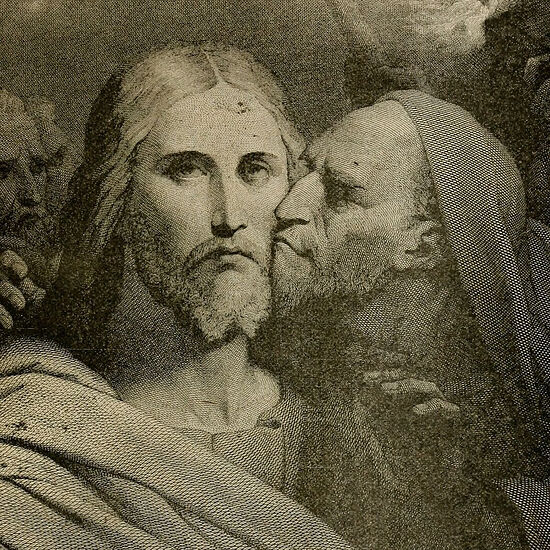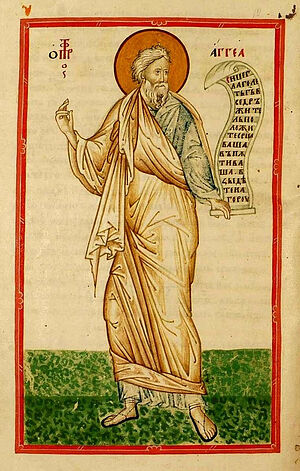Although this new sect is not well known outside of Russia, it appears to be trying to reach new audiences in other languages on the internet. It is nothing particularly new in the world of “self-help” and “empowerment” sects, and this warning could be applied to other similar organizations that we in the West (especially in the U.S.) have been dealing with for decades, such as Scientology, Erhard Seminars Training (EST), Tony Robbins’ Unleash the Power Within (UPW), The 7 Habits of Highly Effective People, Montessori, and scores of others.

In my practice as a priest, I came across something new to me—the online “Super Jump” courses.
One of my parishioners asked me to study this matter and give an Orthodox evaluation, because an Orthodox priest’s wife she knows is a trainer in this organization, has highly recommended these courses to her daughter, and peddles them to others. I looked into it, and it turns out that there are already trainers and clients amongst the parishioners of my parish. I think that by force of the pushy advertisement of this “supermethod” propaganda in the Russian language internet, most likely its followers can be found in other parishes of our Church as well.
The “Super Jump” courses, according to its claims, is a system of intellectual and physical exercises intended to develop the mind, raise energy levels, and control one’s emotional state; it is also called “adult learning”. Thus, it is supposedly a set of various training techniques for a successful life and personal growth.1
The courses were developed by an entrepreneur of dubious reputation, Vladimir Dovgan, in 2015. At the present time, he has changed his surname to Schastlivy (Russian for Happy, Lucky), and often signs his books with the pseudonym, Velichaishy (Supreme, Greatest). He lives outside of Russia.2
In his motivational video clips and texts, Dovgan says that he spent decades and somewhere between 300-400 thousand dollars on the development of his “unique revolutionary method”.
The aim of the courses is this: on the personal level, the attainment of happiness and emotional harmony due to a radically heightened level of inner energy; and on the global level, nothing less than salvation of the world and all mankind from ecological catastrophe and self-destruction.3
The actual and obvious aim is the creation of a network of material enrichment, fueled by the sale of internet courses.
Anyone who has completed training in the intellect clubs and online courses of Super Jump immediately receives the opportunity to become an intellect trainer who can teach other participants.4
Trainers of the “International Association of Super Jump Intellect Trainers” pretentiously call themselves coaches, psychologists, and educators, though they often have no higher education, never mind any special psychological or educational background.
A strange and dangerous situation arises when unqualified individuals undertake to solve the spiritual and physical problems of others without possessing sufficient knowledge, skills, cultural level, or life experience, armed with some new method of dubious character touted as a panacea. Involuntarily, the Gospel proverb comes to mind: Physician, heal thyself (Luke 4:23).
Students pay coaches for their classes (one hundred dollars for a course, ten dollars for each session), and coaches give a certain percentage to their own coaches, on up to the founding coach. The more students and coaches, the more profit.
This forms a commercial pyramid network of multi-level marketing (MLM).5
In the “Super Jump” courses, students are offered to master eight fairly simple psychophysiological exercises that are supposed to radically change their lives for the better.6 One lesson is allocated for each exercise. On the last two lessons, students are given motivation to purchase a license to call themselves “intellect coaches” for the price of 3300 dollars.
The entire course consists of ten hourly sessions conducted online using video conferencing software (VCS) early in the morning (from 7:00).
The first exercise is called “200 smiles.”7 You need to smile at least 200 times every day. According to the coach, frequent smiling generates a positive energy field around you, attracting other people to you and connecting you with the Universe as a source of energy. To remind yourself of this rule, you need to draw a smiley face on your left hand. You can look at it and smile.
As an additional technique, you can deeply inhale and joyfully laugh on the exhale as often as possible. This should provide oxygen flow to the brain, improve mood, and, of course, strengthen the positive energy field.
The second exercise is called “I am the master of my thoughts” (other names: “rubber band,” “billionaire bracelet”).8 You need to put a rubber band from a banknote package on the same hand where the smiley face is drawn. Use it to painfully slap yourself on the hand when negative thoughts arise in your mind, and then replace them with positive ones.
In this way, a person engages in self-discipline, developing a conditioned reflex: negative though–pain–positive thought. Inflicting pain on oneself should switch the brain from negativity to positivity. As a result, the person will supposedly be cleansed of negative energy and fully attuned to a positive energy vibe, entering into even greater unity with the Universe.
The third exercise is called “Posture of the King/Queen.”9 One must not slouch. It is necessary to stand straight with the head held high. A person’s royal posture should express his conviction in his uniqueness, individuality, and greatness. To achieve this, one should frequently tell themselves: “I am the king of kings” or “I am the queen of queens.” In order to never forget this, it is necessary to draw a crown next to the smiley face on the left hand and look at it as often as possible to smile, straighten up, and engage in self-praise. The majestic posture along with the auto-training of self-confidence should, according to self-proclaimed psychologists, improve self-esteem, health, and stimulate the internal and external development of the individual, enhancing the same personal energy level.
The fourth method is called “Be Healthy”, and essentially represents hardening yourself by dowsing yourself with cold water.10 According to the pseudoscientific assurances of these self-proclaimed doctors, water is the main element of the Universe, possessing life, mind, attention, and memory. Therefore, it can absorb information available to it and transmit it to those who come into contact with it. In other words, water can be filled with good information and charged with positive energy, which can then be used for one’s own health and positive energy charging.11
This is the program’s pseudoscientific theory. In practice, one needs to fill a basin with cold water, undress, utter words of love and gratitude to Mother Nature over the water, thereby charging it with positive energy, and pour it over oneself. This should be done at least once a day. The more often, the better. The water ideally should be icy, because according to the trainer’s assurances, this sharply raises the body temperature, and all its cells are renewed and rejuvenated. It is best to do this outdoors, in nature or, in extreme cases, on your balcony.
In addition to the personal health effects, this procedure, according to these self-proclaimed ecologists, also has a beneficial effect on the state of the entire planet. They claim that the acknowledgment of love for the Universe and pouring water by tens of thousands of “Super Jump” followers around the world has a global, planetary, saving effect—it maintains and enhances the positive energy-informational field of Earth.
At the same time, the newly minted healers make no adjustments for individual organisms or health conditions. Pouring ice-cold “enchanted” water is simply declared a cure for all diseases. This is of course untrue, and contradicts official medicine.
From a medical standpoint, cold water procedures are dangerous for cardiovascular diseases, disorders of the nervous system, acute mental disorders, skin diseases, burns, severe injuries, bleeding, hypertension, renal and hepatic colic, respiratory diseases, and acute respiratory viral infections or the flu, and exacerbates chronic diseases.12
As is known, a similar teaching was preached by the late neo-pagan Porfiry Ivanov, whose followers called him the Victor of Nature, the Teacher of the People, the God of the Earth.13 Apparently, it was from him that Vladimir Dovgan borrowed the fourth exercise of his system, as well as the underlying idea of worshiping Mother Nature, supplementing it with the teaching of information-energy fields. The latter is borrowed from the pseudoscientific trend called “bioenergo-information”, which emerged back in the 1970s.14
Thus, the “Super Jump” courses, which were initially presented as a harmless psychophysiological technique for personal growth, acquire at the fourth stage obvious features of religious neo-pagan teachings and practice. Pouring “charged” ice water with a prayerful appeal to Mother Nature takes on the character of pseudo-religious initiation, representing a kind of “baptismal sacrament”. Therefore, “Super Jump” is not just a commercial pyramid selling a dubious method of personal success, but a networked neo-pagan sect with its own doctrine and cult practice.15
The fifth method is called, “I am the master of my feelings”, and consists of not responding with evil to evil, force to force, offense to insult, rudeness to rudeness, negativity to negativity, and never seeking revenge.16 After all, all this accumulates negative energy around a person and destroys the positive information-energy field of both oneself and the entire Earth. To cope with rising anger in moments of attack, a person needs to count backward, for example, from a thousand to one. Counting backward allows one to turn away the attention, calm down, delay an immediate reaction, and not be rude to the offender. Counting backward is difficult; it requires more attention and concentration. And to always remind oneself of this, one should draw the number 100 or 1000 next to the smiley face with a crown on their left hand.
The “master of one’s feelings” directly echoes the “master of one’s thoughts,” the second technique of the training, and is its derivative. There is nothing fundamentally new here. The person must fight with negative thoughts by hitting himself with a rubber band on the wrist, and with negative feelings by counting backward.
This recommendation itself is a well-known ethical norm. There is nothing unique about it. It was formulated in Hinduism, Buddhism, and Jainism as the principle of ahimsa, in Christianity as the commandment of not resisting evil, in Tolstoyism as the virtue of non-forceful resistance to evil, as well as in many other teachings.
Pacifism is undoubtedly useful in terms of personal spiritual development. However, it is flawed in situations where it is necessary to defend your loved ones from a direct threat and aggression. In such cases, it is necessary not to withdraw oneself but to “lay down one’s life for one’s friends” (cf. John 15:13).17
The sixth technique is called, “Audio Training”, or self-suggestion using a recording device.18 A person needs to make an audio recording of words expressed their highest self-esteem, formulating his highest desired achievements, and his most grandiose dreams. He is supposed to say that he is the greatest, the smartest, the most talented, the most beautiful, the richest, and the coolest winner of all and everything. This recording should be listened to for at least one hour a day, preferably longer. In the end, according to the trainer’s assurance, these words will materialize, manifest in reality, and the person will indeed become the “king of kings” and the conqueror of all problems. The person is instilled with the belief that presenting what he wants as a reality will inevitably lead to a positive change in reality.
The sixth method clearly echoes the third. It is called “the posture of the king and queen.” In the third, self-suggestion of one’s own greatness is realized through bodily posture and internal self-praise; in the sixth, through words and hearing.
From a Christian point of view, we see a direct appeal to self-love, pride, and vanity. According to the holy fathers, pride is the root and cause of all sinful passions. It is totally destructive for a person’s spiritual development and eternal salvation. Pride is the opposite of humility, and humility is the source of all virtues, and the basis for true spiritual development and salvation.19
The “Super Jump” courses instill an anti-Christian approach. Pride in the form of megalomania is elevated to the main virtue, while humility is entirely rejected. Instead of faith in God, faith in oneself is proposed, and instead of theocentrism, anthropocentrism is preached.
Thus, the “Super Jump” courses, like other life success and personal growth trainings that are based on self-suggestion of belief in oneself and one’s success, contradict the Christian consciousness and way of life, which are based on the virtue of humility and faith in God.20 In my opinion, any participation by Orthodox Christians in such trainings, whether as a student or even more so as an instructor, is incompatible with Christian faith and therefore unacceptable.
The seventh technique is called, “Protect Yourself from Informational Poison.” It involves refraining from watching informational and other programs on television and the internet, clearing the phone memory of all “negative” photos and videos, and deleting the phone numbers of “negative,” “toxic” people.21
All this needs to be done to achieve success. After all, useless and negative people and information hold us back and drag us down, preventing us from developing. Therefore, a person must build a wall between himself and his familiar informational and human environment, which is declared the source of evil in his life.
On the one hand, these recommendations have a healthy core consisting of informational and communicative hygiene. Indeed, in our information age, people suffer from an excess of negative information, from informational (internet and/or gadget) addiction, and from aggression in their environment.
On the other hand, these recommendations indicate a strict division of the world into “us” and “them,” the enlightened and those in the darkness of ignorance, the saved and the damned. Thus, individuals are pushed to gradually abandon the values of the evil, negative, “sinful world,” sever their ties with it, and become full-fledged members of the benevolent and positive community of the saved, the “Super Jump” family, preaching its saving doctrine.
The eighth exercise is called, “Supergoal”, and involves setting oneself a certain higher task.22 The higher and more complex the goal a person sets for themselves, the greater results they can achieve as they progress towards that goal. According to the coach’s assurances, this supergoal should be the salvation of the world from destruction that may result from ecological catastrophes, wars, human greed, and other threats. If a person strives for this goal using the path proposed by Vladimir Dovgan (also known as the “Great and Happy”), then all material goods will naturally flow to them.
The content of the ninth session is about the international association “Super Jump,” which claims to be an organization for saving the world from unconsciousness, environmental problems, ignorance, malice, and self-destruction for the sake of a happy future for future generations.
At the same time, according to Dovgan’s promises, intellect-trainers have the opportunity to earn fabulous amounts of money.23
Only those who have embraced the practice of this new religion will survive, while those who are not initiated condemn themselves to a life of poverty, and will ultimately perish. The wicked will destroy themselves, while the virtuous will prosper.
Thus, in the minds of “Super Jump” followers, humanity is definitively divided into those who are saved and those who are doomed. If the goal of the methodology is to save the world, then its recommendations become commandments, the entire methodology becomes a doctrine and practice for salvation, its founder becomes a teacher or prophet of salvation, and the organization he leads becomes a pseudo-religious church or sect. One is saved by following the teacher’s commandments, while failure to do so leads to destruction. This is the key principle instilled in Dovgan’s followers, and their creed.
In the concluding tenth session, the trainer suggests that listeners themselves become intellect-trainers, practically apostles of the new pseudo-religion. All one needs to do is purchase a license costing $3300, or when discounts are offered, for $3000. In return, the newly appointed trainer will receive pre-written speeches to deliver to the audience, which they simply need to adapt to themselves.
From this point on, individuals can begin their commercial and simultaneously evangelical activities, earning money by “saving” new clients and/or followers.
During interactions with students during sessions, trainers use classic techniques for recruiting new members:
These are all classic techniques used in manipulative or coercive groups:
-
Drawing attention to personal problems and showing sympathy: This builds trust and creates vulnerability, making individuals more receptive to the group’s influence.
-
Creating a sense of inadequacy: By implying that individuals are living incorrectly if they don’t adhere to Dovgan’s teachings, the group fosters a feeling of inadequacy that can only be resolved by following their guidance.
-
Glorifying the methodology as a unique universal panacea: By presenting their method as revolutionary and unparalleled, the group instills a belief in its infallibility and superiority.
-
Excessive positive attention and care towards participants: Overstepping boundaries of communication and personal space, excessive praise, and boosting the ego of participants create dependency and loyalty to the group.
-
Building trust and imposing confessional practices: By fostering an environment of trust and openness, the group encourages individuals to divulge personal information, which can later be used for manipulation or control.
-
Replacing old social circles with the group: By encouraging members to distance themselves from old relationships and form new ones within the group, individuals become reliant on the group for social support and belonging.
-
Involvement in the “new family”: By positioning the group as a new, powerful organization or pseudo-church, individuals are made to feel dependent on the group for their well-being and salvation.
-
Imposing radical positive thinking: By promoting an ideology of radical positivity, the group sets its members apart from those who do not possess such thinking, reinforcing a sense of superiority and allegiance to the group.
-
Rigid division of humanity: By dividing humanity into insiders and outsiders, positive and negative, those who are saved and those who are doomed, the group reinforces loyalty and obedience among its members.
-
Messianic idea: By presenting the group as the savior of humanity from impending catastrophe and offering membership as a means of salvation, individuals are motivated to stay within the group to fulfill their role in saving others and themselves.24
In conclusion, the “International Association of Super Jump Intellectual Trainers” is a networked commercial sect of a neopagan nature. Its methods of psychological and physiological influence on individuals, both individually and collectively, contrary to the statements of its founder and followers, are not unique, revolutionary, or salvational. Some of them are well-known, others are highly dubious and pseudoscientific, and still others are downright dangerous to mental and physical health. Despite loud declarations, its real goal is to make money through deceitful manipulative practices on gullible people.25
In its pseudo-religious and pseudo-spiritual settings, the “Super Jump” system is opposed to the Christian belief in God the Creator, and to moral values such as humility, meekness, patience, and honesty.
Orthodox Christians must clearly understand that by becoming a member of the “Super Jump” organization and propagating its ideas and methods, they become accomplices in sinful deeds—both falling into temptation themselves and leading others into it.
Let us remember the stern words of the Lord:
Whoever causes one of these little ones who believe in Me to sin, it would be better for him to have a great millstone fastened around his neck and to be drowned in the depth of the sea. Woe to the world for temptations to sin! For it is necessary that temptations come, but woe to the one by whom the temptation comes! (Matt. 18:6–7).
 Photo: sparklogic.ru
Photo: sparklogic.ru 


